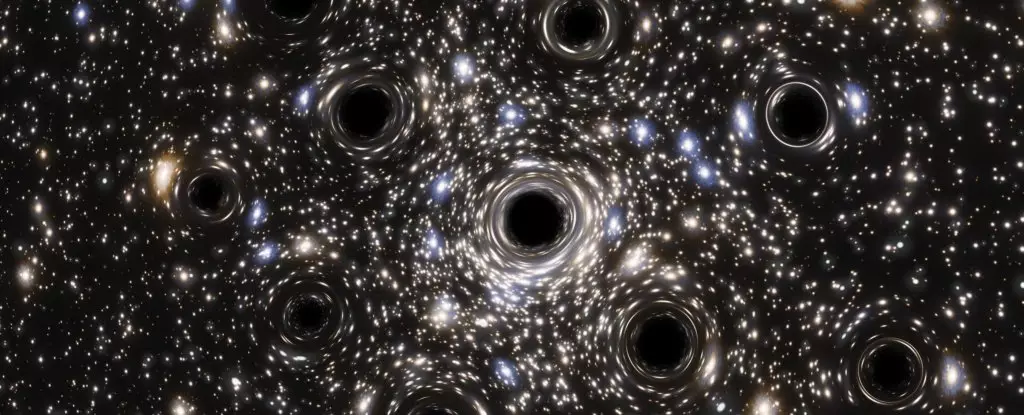In the grand tapestry of the universe, clusters of stars serve as time capsules that link us to the cosmos’ formative years. Among these stellar assemblages lies the Palomar 5 cluster, a captivating cosmic entity situated approximately 80,000 light-years away from Earth. This cluster, characterized by its loose scattering of stars, has recently attracted attention due to the groundbreaking research that suggests it harbors a population of over 100 stellar-mass black holes at its core. Such findings not only expand our understanding of black hole formation but also provoke larger questions surrounding the evolutionary destiny of star clusters.
Globular clusters can be likened to ancient relics — dense clusters that provide a window into the early universe. Typically consisting of between 100,000 to a million stars, these clusters are often spherical in shape and composed predominantly of older stars, some dating back nearly to the universe’s inception. Notably, the Milky Way houses roughly 150 known globular clusters, each functioning as natural laboratories that inform us about galactic formation, dark matter distribution, and the evolution of celestial bodies. Nonetheless, while these globular clusters are valuable, a newer category of stellar distribution, known as tidal streams, is gaining traction amongst researchers.
Tidal streams are elongated formations of stars that stretch across vast distances in the sky. Traditionally, identifying these structures proved challenging; however, the Gaia space observatory has revolutionized our ability to map the Milky Way in three dimensions. Researchers have recently turned their attention to these tidal streams, aiming to decipher their origins and cosmic significance. Mark Gieles, an astrophysicist from the University of Barcelona, posits that tidal streams may originate from the disruption of star clusters. However, until that hypothesis was put to the test with clusters like Palomar 5, researchers lacked sufficient evidence.
Palomar 5 stands out due to its extraordinarily dispersed star distribution and a tidal stream that extends over 20 degrees in the night sky. Gieles and his team focused on Palomar 5 as it is the only known cluster associated with a tidal stream, thereby serving as a ‘Rosetta Stone’ for understanding the formation of such streams. By utilizing advanced N-body simulations, they reconstructed the orbits and evolutionary paths of individual stars to glean insights into the dynamics of this cluster. Interestingly, the model included the potential influence of stellar-mass black holes, a common subject of inquiry due to their significant effect on surrounding stellar populations.
The simulations yielded startling insights regarding black hole populations within Palomar 5. Results indicated that the number of stellar-mass black holes is approximately three times higher than previously anticipated, constituting more than 20% of the cluster’s total mass. Each black hole is estimated to have a mass about 20 times that of the Sun, and they likely formed from supernova explosions that occurred during the cluster’s youth. Notably, this overabundance directly influences the fate of Palomar 5 and may set a precedent for understanding other globular clusters.
According to Gieles’ simulations, the eventual trajectory of Palomar 5 predicts its complete dissolution within the next billion years, transitioning entirely into a stellar stream. This phenomenon infers a broader trend that many globular clusters may suffer the same fate. As clusters disintegrate, they might release a significant number of black holes into the galactic environment, raising intriguing prospects for future cosmic interactions.
The ramifications of the Palomar 5 study extend far beyond the cluster itself. For instance, the research reinforces the possibility that countless black hole mergers might occur in star clusters, creating ripples through the fabric of space-time. Such discoveries urge astrophysicists to reflect on the nature and quantity of black holes in clusters, which remains a fundamental challenge as black holes cannot be directly observed. As the quest for knowledge about these enigmatic entities progresses, clusters like Palomar 5 will undoubtedly continue to shed light on the hidden complexities of our universe.
Through meticulous investigation, researchers like Gieles are piecing together the cosmic puzzle of tidal streams and black holes. The unique case of Palomar 5 not only provides a meaningful reflection on the past epochs of the universe but also lays the groundwork for future explorations into the intricate interplay of stars, black holes, and the fate of globular clusters. As a focal point for ongoing research, Palomar 5 invites us to look deeper into the cosmos, challenging us to unravel the mysteries that lie beyond our own starry sky.


Leave a Reply